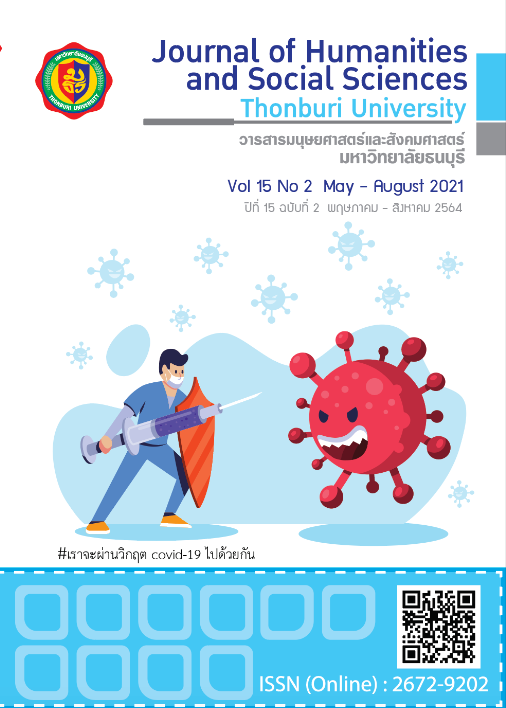The expected Chinese language competence of undergraduate students who studied the Chinese language course in Mahidol University
Keywords:
expectation, Chinese language competence, Chinese language course, undergraduate studentsAbstract
This research aimed to 1) study the current level and the expected level of the Chinese language competence of undergraduate students who studied the Chinese language course in Mahidol University 2) compare their current level and the expected level of Chinese language competence and 3) study their needs for Chinese course improvement. For collecting the data, a questionnaire was answered by 66 students registered into the Chinese language course in Mahidol University in the first semester of academic year 2019. Means, standard deviation, and t-test dependent were used for data analysis. The results showed that 1) students had Chinese language competence regarding listening and speaking skills at a low level and the competence on reading and writing skills at the minimum; however, they expected on listening, reading and writing skills at a high level, and speaking skill at a highest level. 2) Students had expectation in the Chinese language competence higher than the current Chinese language competence in every respect with the statistical significance at the level of .05. 3) Students mostly needed to develop the learning content, learning activity, and learning assessment at a high level. The learning content and learning activity on hypothetical situation for using the language in a fun way and promoting the use of language and learning assessment focusing on learning development periodically were their priority needs.
References
กระทรวงศึกษาธิการ. สำนักงานปลัดกระทรวงศึกษาธิการ. (2559). แผนพัฒนาการศึกษาของกระทรวงศึกษาธิการ ฉบับที่ 12 (พ.ศ. 2560 - 2564). กรุงเทพฯ: สำนักงานปลัดกระทรวงศึกษาธิการ กระทรวงศึกษาธิการ.
จรัสศรี จิรภาส. (2550). ศักยภาพของบัณฑิตภาษาจีนระดับอุดมศึกษาและข้อคิดเห็นเกี่ยวกับการพัฒนาหลักสูตรภาษาจีนระดับอุดมศึกษาให้ได้ประสิทธิภาพ. วารสารศิลปศาสตร์ปริทัศน์. 2(3): 39-49.
จิรพร เข็มเพ็ชร์. (2560). ความพึงพอใจของนักศึกษามหาวิทยาลัยธุรกิจบัณฑิตย์ที่มีต่อรายวิชาภาษาจีนเพื่อการสื่อสาร. กรุงเทพฯ: มหาวิทยาลัยธุรกิจบัณฑิตย์.
ฉิงยู เฉิน. (2560). ความต้องการในการเรียนภาษาจีนของนักศึกษาระดับอาชีวศึกษา: กรณีศึกษาวิทยาลัยเทคโนโลยีชลบุรีบริหารธุรกิจ. การศึกษาค้นคว้าอิสระบริหารธุรกิจมหาบัณฑิต สาขาการจัดการองค์การสมัยใหม่ มหาวิทยาลัยศรีปทุม.
สำนักงานคณะกรรมการการอุดมศึกษา. (2557). คู่มือการประกันคุณภาพการศึกษาภายในระดับอุดมศึกษา พ.ศ.2557. นนทบุรี: ภาพพิมพ์.
สำนักงานเลขาธิการสภาการศึกษา. (2560). แผนการศึกษาแห่งชาติ พ.ศ. 2560-2579. กรุงเทพฯ: สำนักฯ.
สุวรรณ เลียงหิรัญถาวร. (2556). การศึกษาสภาพการจัดการเรียนการสอนภาษาจีนในโรงเรียนมัธยมศึกษาตอนปลายของจังหวัดเชียงใหม่. วารสารคณะศิลปศาสตร์ มหาวิทยาลัยแม่โจ้. 1(2): 43-59.
อดิเรก นวลศรี และปิยนันต์ คล้ายจันทร์. (2558). ความต้องการในการจัดการเรียนการสอนภาษาจีนระดับประถมศึกษาในโรงเรียนสังกัดเทศบาลนครปากเกร็ด. วารสารปัญญาภิวัฒน์. 7(2): 196-206.
Arnolds, C. A., & Boshoff, C. (2003). The Influence of McClelland’s Need Satisfaction Theory on employee job performance. Journal of African Business. 4(3): 55–81.
Narciss, S., Körndle, H., & Dresel, M. (2008). Accuracy of self-evaluation of competence: How is it affected through feedback in a computer-based arithmetic training? In J. Zumbach, N. Schwartz, T. Seufert, and L. Kester (eds.), Beyond knowledge: the legacy of competence. Austria: Springer.
Rothwell, W. J., & Graber, J. M. (2010). Competency-based training basics. New York: ASTD.
Tyler, R. W. (1950). Basic principles of curriculum and instruction. Chicago: University of Chicago Press.
Yang, Jizhou., Qiu, Jun, & Li, Ning . (2005). TCFL primary stage syllabus. 3rded. Beijing: Beijing Language and Culture University Press.
Zeng, M. (2016). A handbook of tasks and rubrics for teaching Mandarin Chinese. Beijing: Beijing Language and Culture University Press.
Zhang, Hui., & Yang, Nan. (2006). Chinese language comprehensive course instructional methodologies. Beijing: Beijing Language and Culture University Press.
Translated Thai References
Chen, Q. (2017). The needs of vocational education students in learning Chinese: a case study in Chonburi Business Administration Technological College. (Master of Business Administration Independent Study, Sripatum University). (in Thai)
Jirapas, J. (2007). The Potential of Chinese graduates in higher education and the opinion toward Chinese program development effectively. Journal of Liberal Arts Review, 2(3), 39-49. (in Thai)
Khempet, Jiraporn. (2017). The satisfaction of Dhurakij Pundit University’s students with Chinese for communication course. Bangkok: Dhurakij Pundit University. (in Thai)
Lianghirantaworn, S. (2013). A study of Chinese teaching and learning at high school in Chiang Mai. Journal of Liberal Arts, Maejo University. 1(2): 43-59. (in Thai)
Nuansri, A., & Klaichun, P. (2015). The needs of Chinese teaching and learning in the elementary school in municipality Pakkhet city area. Panyapiwat Journal. 7(2): 196-206. (in Thai)
Office of the Education Council, Ministry of Education. (2015). The national education plan B.E. 2560-2579 (2017-2036). Bangkok: Office of the Education Council, Ministry of Education. (in Thai)
Office of the Higher Education Commission. (2014). Manual for the internal quality assurance for higher education institutions 2014. Nontaburi: Parbpim. (in Thai)
Office of the Permanent Secretary. Ministry of Education. (2016). 12th MOE’s education development plan (2017-2021). Bangkok: Office of the Permanent Secretary, Ministry of Education. (in Thai)







